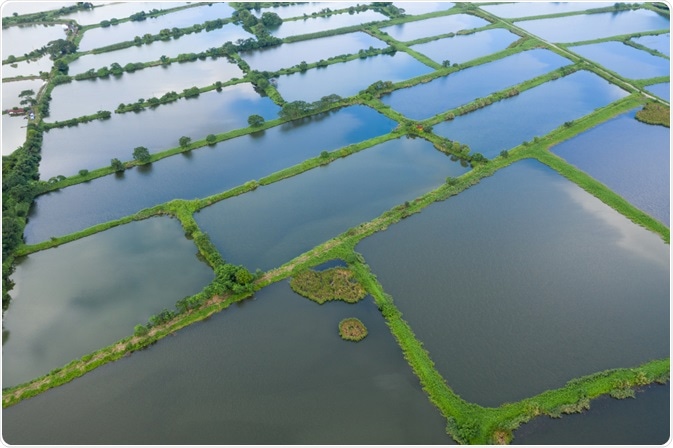Hatcheries are the backbone of the aquaculture, or aquafarming, where multiple species of fish, mollusks, crustaceans, and aquatic plants, algae, and other organisms are grown in a controlled manner.

Image Credit: leungchopan/Shutterstock.com
The industry of aquaculture is one of the fastest-growing sectors in the food production space, with around 40% of all fish that end up as food for humans being produced in hatcheries.
Hatcheries are almost like farms but are also similar to laboratories. The aquatic species are spawned, hatched, and monitored by the hatchery workers. Once they are large enough, the fish or shellfish are transferred into a farm or sometimes they are released into the wild.
Hatcheries have become popular because they provide a reliable source of stock replenishment for the world’s waters which are becoming intensely over-farmed.
The last decade has seen a rapid rise in the use of hatcheries due to several factors, such as the rising demand for food as the population continues to grow, the effects of over-fishing leaving natural fish populations low, and the effects of climate change impacting aquatic ecosystems.
While hatcheries help boost food sources, they are not without their drawbacks. They are becoming increasingly controversial because of the detrimental impact on the environment, human health, and fish health that they have been associated with.
The benefits of fish hatcheries
There are numerous benefits of fish hatcheries that have led to them being so popular. To begin with, as a result of the increasing demand for food, the oceans and seas have become heavily farmed.
Hatcheries allow for the replenishment of fish in these waters, at a rate much faster than nature would allow. This allows consumers to gain access to a guaranteed supply of seafood, as well as ensuring farmers will continue to generate revenue from farming the animals.
Also, hatcheries can provide food sources to carnivorous fish, enabling their continued supply.
Recent years have seen the rise in popularity of the seafood diet due to its plentiful health benefits reported by many scientific studies. Today, protein and Omega-3 has become a focus of many people’s diets for muscle growth, memory function, eye health, lower risk of heart disease, and more.
Seafood is naturally high in these substances, which are not only beneficial to the general population but can also impact on communities where malnutrition is an issue, helping people gain access to nutrient-dense food. Hatcheries can ensure a regular supply of this essential food source.
Many cultures are heavily reliant on the aquaculture industry to provide jobs in areas where poverty and unemployment is rife. In China, for instance, fish hatcheries employ around 4.3 million workers, making it a key industry for the country’s economy.
The process of running fish hatcheries is very labor-intensive and demands a lot of manpower, therefore, the industry can make a significant impact on employment rates in a community and provide an important boost to their economy.
Finally, some fish hatcheries in Europe are dedicated to conserving rare aquatic species which is helping to protect them from disappearing from ecosystems across the region.
The drawbacks of fish hatcheries
While there are numerous benefits to fish hatcheries, it can be argued that the drawbacks outweigh these advantages. Firstly, fish hatcheries have been identified as a source of pollution to aquatic environments due to some of its practices.
Also, because these fish are farmed in very dense conditions, their waste products become more concentrated, which can favor the development of microorganisms that can be directly harmful to the fish.
Also, while the perception of farmed fish is that they are cleaner than wild fish, this is not the case. Studies have shown that farmed fish have higher levels of toxic substances such as antibiotics, organic pollutants, and pesticides than are found in wild fish.
Consumers eating farmed fish are, therefore, at risk of the adverse health effects associated with consuming these contaminants. Pregnant and nursing women are of particular risk to these detrimental health effects.
Studies have also shown that fish from hatcheries have lower reproductive success than wild fish. This poses a problem when hatchery fish are introduced into wild populations because it may be having a detrimental impact on the fitness of the entire population.
Disease is also rife in fish hatcheries that are poorly managed. Lice, for example, are common in these environments, which can impact the quality and health of the fish. Diseases established in fish farms can easily spread to wild fish and put the entire population at risk.
Finally, it is known that fish feel pain and experience stress. Hatcheries by their nature raise fish in very confined, stressful environments and kill them inhumanely by asphyxiation, evisceration, or starvation.
Overall, there are a lot of significant drawbacks associated with hatcheries. While this method of farming helps maintain levels of a precious food resource, provides jobs, and helps tackle malnutrition, the practices involved in hatcheries are in desperate need of updating to protect the environment, human health, and respect the lives of the fish that are being farmed.
Sources:
- Christie, M., Ford, M. and Blouin, M. (2014). On the reproductive success of early-generation hatchery fish in the wild. Evolutionary Applications, 7(8), pp.883-896. https://onlinelibrary.wiley.com/doi/full/10.1111/eva.12183
- Cole, D., Cole, R., Gaydos, S., Gray, J., Hyland, G., Jacques, M., Powell-Dunford, N., Sawhney, C. and Au, W. (2009). Aquaculture: Environmental, toxicological, and health issues. International Journal of Hygiene and Environmental Health, 212(4), pp.369-377. www.sciencedirect.com/science/article/abs/pii/S1438463908000631
- Levin, P., Zabel, R. and Williams, J. (2001). The road to extinction is paved with good intentions: negative association of fish hatcheries with threatened salmon. Proceedings of the Royal Society of London. Series B: Biological Sciences, 268(1472), pp.1153-1158. https://royalsocietypublishing.org/doi/abs/10.1098/rspb.2001.1634
Further Reading
Last Updated: Mar 19, 2020